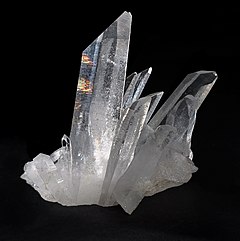Quartz
Quartz
| Quartz | |
|---|---|
 Quartz crystal cluster from Tibet | |
| General | |
| Category | Oxide mineral |
| Chemical formula | Silica (silicon dioxide, SiO2) |
| Strunz classification | 04.DA.05 |
| Dana classification | 75.01.03.01 |
| Identification | |
| Color | Colorless through various colors to black |
| Crystal habit | 6-sided prism ending in 6-sided pyramid (typical), drusy, fine-grained to microcrystalline, massive |
| Crystal system | α-quartz: trigonal trapezohedral class 3 2; β-quartz: hexagonal 622[1] |
| Twinning | Common Dauphine law, Brazil law and Japan law |
| Cleavage | {0110} Indistinct |
| Fracture | Conchoidal |
| Tenacity | Brittle |
| Mohs scale hardness | 7 - lower in impure varieties |
| Luster | Vitreous - waxy to dull when massive |
| Streak | White |
| Diaphaneity | Transparent to nearly opaque |
| Specific gravity | 2.65; variable 2.59 - 2.63 in impure varieties |
| Optical properties | Uniaxial (+) |
| Refractive index | nω = 1.543 - 1.545 nε = 1.552 - 1.554 |
| Birefringence | +0.009 (B-G interval) |
| Pleochroism | None |
| Melting point | 1670 °C (β tridymite) 1713 °C (β cristobalite)[1] |
| Solubility | 1 ppmmass at 400 °C and 500 lb/in2 to 2600 ppmmass at 500 °C and 1500 lb/in2[1] |
| Other characteristics | Piezoelectric, pyroelectric, may be triboluminescent |
| References | [2][3][4][5] |

|
Àyọkà yìí tàbí apá rẹ̀ únfẹ́ àtúnṣe sí. Ẹ le fẹ̀ jù báyìí lọ tàbí kí ẹ ṣàtúnṣe rẹ̀ lọ́nà tí yíò mu kúnrẹ́rẹ́. Ẹ ran Wikipedia lọ́wọ́ láti fẹ̀ẹ́ jù báyìí lọ. |
Itokasi àtúnṣe
- ↑ 1.0 1.1 1.2 Deer, W. A., R. A. Howie and J. Zussman, An Introduction to the Rock Forming Minerals, Logman, 1966, pp. 340-355 ISBN 0-582-44210-9
- ↑ Handbook of Mineralogy. Quartz
- ↑ Mindat. Quartz
- ↑ Webmineral. Quartz
- ↑ Hurlbut, Cornelius S.; Klein, Cornelis (1985). Manual of Mineralogy (20 ed.). ISBN 0-471-80580-7.